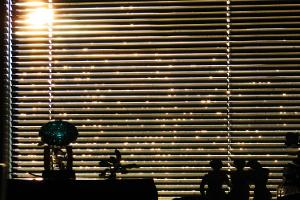 Light and temperature control is vital in a commercial or residential space to ensure the comfort of users. In that sense, the use of blinds is a tool that allows this control to be carried out efficiently and economically. by Alejandra García Vélez
Light and temperature control is vital in a commercial or residential space to ensure the comfort of users. In that sense, the use of blinds is a tool that allows this control to be carried out efficiently and economically. by Alejandra García Vélez
Much is said about lighting as both a functional and aesthetic element within residential and commercial installations, but the role of an element that goes hand in hand with luminaires to offer ideal light control is rarely mentioned: blinds. In particular, the automated blinds or curtains that are responsible for controlling, among other things, the passage of natural light, an essential element when designing a lighting system that uses this resource to the maximum in order to generate greater energy savings and a higher level of comfort for the user. This was expressed by Alejandra León, Senior Marketing of Lutron for Latin America, "curtains and blinds allow to effectively control natural light, reducing the absorption of heat from the sun or heat loss during the winter, helping to reduce cooling and heating costs," he explained. Perfect union
Design and functionality will always be two elements that codependent in any type of installation, but in the case of one that seeks to maximize the level of energy efficiency is indispensable. According to León, the blinds provide control over the natural light of the environments, eliminating the brightness that enters through the windows and reducing the need to use electric light by being able to take advantage of the outside light. "This control of natural light also provides additional comfort for employees who use the space, helping their productivity," added the executive. Obviously, using a simple fabric curtain is not the same as integrating programmable blinds into a fully automated integrated light management system. The latter can be configured to rise or fall according to the schedule or the intensity of the light without having to be manipulated by users. For the guest, this type of functionality guarantees that users have a perfect mix between comfort and efficiency. Of course, they must work together with other elements, such as attenuators and switches, presence sensors, photoelectric sensors and, in general, integrated systems for the control of electric and natural light that present a combination of several strategies.
What's New
It is important to note that the demand for this type of comprehensive systems in Latin America is increasing, as the Lutron official revealed to us. According to her, this is because such systems can offer great energy savings, which is important for companies in the region for which this represents an expense of considerable value. In addition to the environmental awareness and social responsibility that is a trend in all companies in the world today, also drive the installation of devices of this type.
As for the class of specific products that the market is demanding, he points out that it is important to offer a wide range of designs and materials that can adapt to different environments, with references with a modern appearance being the most sought-after. Similarly, in terms of comfort, the automated control is expected to execute its movements silently when opening and closing, to be easy to install and to have the intelligent alignment function, which allows you to open or close all the curtains at the same time. Controlling the light
Moving on to talk about the almost inseparable companion of blinds, lighting, we have the opinion of Jorge Orillac, sales supervisor for Mexico of Lutron Electronics, who explains that in commercial facilities the most important thing is to consider the number of lighting circuits that must be controlled in order to acquire a system that is powerful enough to control the entire building. He also states that in this type of facilities flexibility must be offered, since commercial and office buildings usually have more complex needs in terms of the number of light variables. Among the functions that integrated lighting systems must include, Orillac explains, are centralized control, which allows the management of light and energy consumption directly from a computer, as well as the monitoring of building spaces. Also programming functions that include, for example, the integrated clock function that allows the configuration of lights and curtains. In the same way, the control of maximum use of the energy capacity that allows to regulate peak consumption schedules. In addition to the above, it is advisable to add an additional recommendation that can be easily integrated into a lighting control system and makes it more efficient, that is to take into account the type of task that is performed in the space to determine the necessary lighting levels. Likewise, Orillac draws attention to the issue of overlit spaces that sometimes, by not taking into account natural light, cause an overload of light that affects the user and wastes energy. In this case the use of automated blinds is an excellent tool, as well as the regulation of the luminaires.













